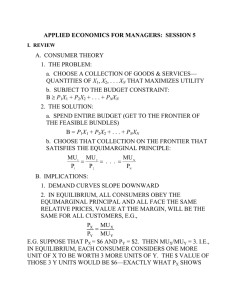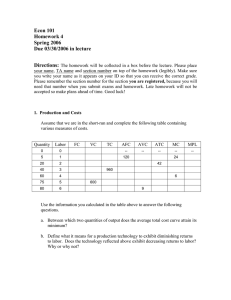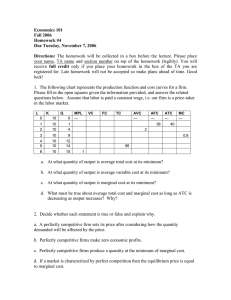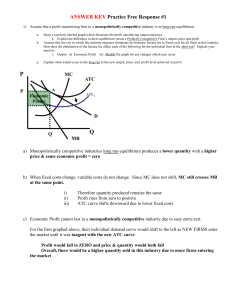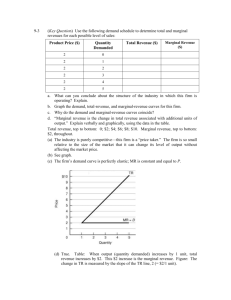Econ 101 Answer Key Homework 4 Spring 2006
advertisement
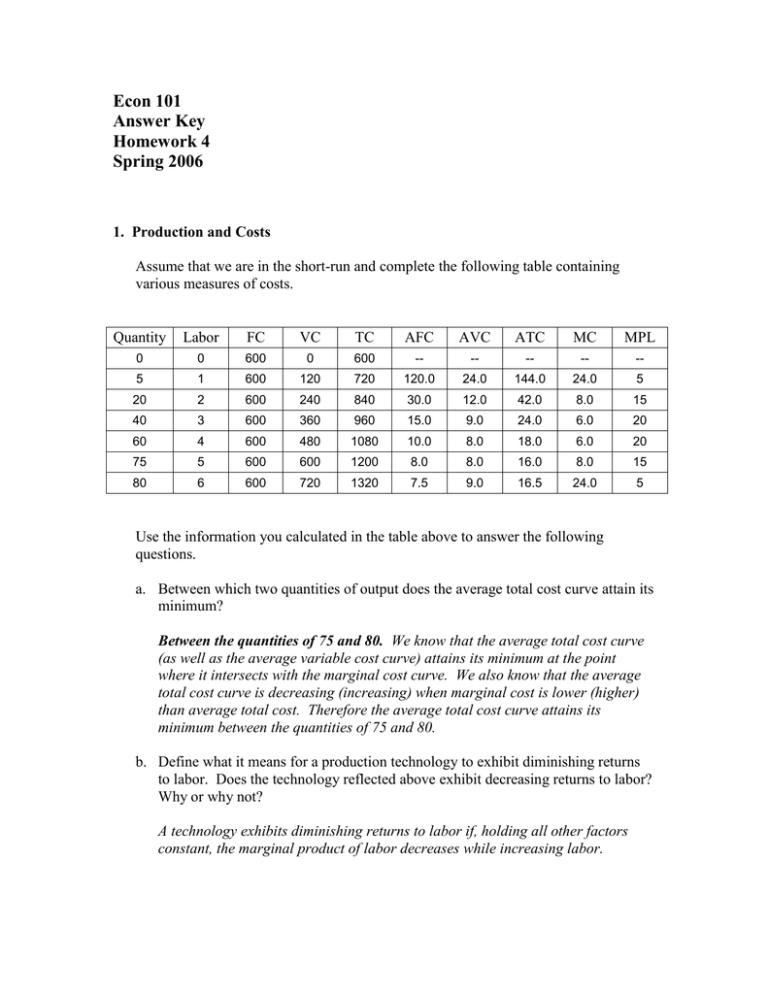
Econ 101 Answer Key Homework 4 Spring 2006 1. Production and Costs Assume that we are in the short-run and complete the following table containing various measures of costs. Quantity Labor FC VC TC AFC AVC ATC MC MPL 0 0 600 0 600 -- -- -- -- -- 5 1 600 120 720 120.0 24.0 144.0 24.0 5 20 2 600 240 840 30.0 12.0 42.0 8.0 15 40 3 600 360 960 15.0 9.0 24.0 6.0 20 60 4 600 480 1080 10.0 8.0 18.0 6.0 20 75 5 600 600 1200 8.0 8.0 16.0 8.0 15 80 6 600 720 1320 7.5 9.0 16.5 24.0 5 Use the information you calculated in the table above to answer the following questions. a. Between which two quantities of output does the average total cost curve attain its minimum? Between the quantities of 75 and 80. We know that the average total cost curve (as well as the average variable cost curve) attains its minimum at the point where it intersects with the marginal cost curve. We also know that the average total cost curve is decreasing (increasing) when marginal cost is lower (higher) than average total cost. Therefore the average total cost curve attains its minimum between the quantities of 75 and 80. b. Define what it means for a production technology to exhibit diminishing returns to labor. Does the technology reflected above exhibit decreasing returns to labor? Why or why not? A technology exhibits diminishing returns to labor if, holding all other factors constant, the marginal product of labor decreases while increasing labor. Yes it does. At first, as the quantity of labor increases, the marginal product of labor is increasing, but eventually towards the end of the table, the marginal product of labor is decreasing as labor is increasing. 2. Perfect Competition The market for gasoline in the City of Madison is characterized by perfect competition. Firms and consumers are price takers and there is free entry and exit. Assume this industry is a constant cost industry. The total cost and marginal cost functions for an individual firm are given by the following equations (assume all firms are identical in terms of their technologies, and therefore their cost functions): TC = (Qs)2 + 2*(Qs) + 9 MC = 2*Qs + 2 (Hint: You do not need the demand equation to solve parts a. and b.) a. What is the equilibrium price that will prevail in the market? P = 8. We know that firms always produce at the minimum of average total cost, and we also know that average total cost attains its minimum when it intersects marginal cost. Since TC and MC are given to us, we just need to construct ATC. ATC = TC/Q = Qs + 2 + 9/Qs Setting this equal to MC gives us: ATC = MC = Qs + 2 + 9/Qs = 2*Qs + 2 9/Qs = Qs 9 = (Qs)2 Qs = 3. Plugging Qs = 3 into either ATC or MC gives us that the price in the market is P = 8. b. What will be the output of each firm in the long-run equilibrium? Qs = 3. In part a. we solved for the long-run equilibrium quantity of each firm. Qs = 3. Suppose that the aggregate demand is given by the following equation: Demand: Pd = 500 – 2*Qd c. How many firms will exist in the long-run equilibrium? 82 firms. We know that each firm will produce 3 units at a price of 8, so we need to find out how many firms are needed to satisfy demand when price equals 8. Plugging P = 8 into the demand equation gives us that the aggregate quantity demanded equals 246. P = 8 = 500 – 2*Qd 2*Qd = 500 – 8 2*Qd = 492 Qd = 246 Since each firm produces a quantity of 3 in the long-run equilibrium, then the number of firms equals 246/3 = 82. Number of firms * Quantity of each firm = Total Quantity Number of firms = Total Quantity / Quantity of each firm Number of firms = 246 / 3= 82. Suppose that the City Council votes for an increase in the price of public transportation such that the new aggregate demand curve for gasoline shifts out and is given by the following equation: Pd = 900 - 2*Qd (Hint: Before diving into calculations think about the questions and about what you know about perfect competition.) d. Will the new short-run profits be negative, positive, or zero? Positive. When demand shifts out (shifts to the right), we know that this is going to lead to a higher equilibrium price and therefore positive profits in the shortrun. e. Will the new long-run profits be negative, positive, or zero? Zero. We know that under perfect competition long-run profits are zero. So even though there are positive profits in the short-run, there will be entry to the point where long-run profits are again zero. f. What will be the new long-run equilibrium price? P = 8. The long-run equilibrium price under perfect competition is always given by the point where ATC attains its minimum. Since the ATC curve has not changed, it still attains its minimum at a price of 8. g. What will be the output of each firm in the new long-run equilibrium? Q = 3. Just like price, the long-run equilibrium output of each firm under perfect competition is always given by the point where ATC attains its minimum. Since the ATC curve has not changed, it still attains its minimum at a quantity of 3. 3. Perfect Competition with a Tax Now suppose that the City Council of Madison notices that due to its increase in the price of public transportation, more people are driving to work and air pollution is increasing. They therefore decide that in order to discourage people from driving, they will issue a $4 excise tax on consumers on the consumption of gasoline. Assume the market demand curve is Pd = 900 – 2Qd. a. What is the new long-run equilibrium price with the tax from a consumer’s perspective and from the firms’ perspective? (Think about this one for a minute before diving into the calculations.) The price from the firms’ perspective is P = 8. Once again the equilibrium price under perfect competition is determined by the minimum of the ATC curve, which is unaffected by the tax. Therefore the price received by producers is still P = 8. For consumers, since there is a $4 per unit tax, that means that the price in the market, and the price paid by consumers is P = 12 (Producer price plus the tax = 8 + 4 = 12). b. Will the number of firms in the long-run equilibrium be higher or lower than without the tax? Lower. Since the excise tax causes a decrease in demand, and since the quantity produced by each firm is unaffected, there will be a lower number of firms in the long-run equilibrium with the tax. c. What will happen to firm profits in the short-run due to the tax? Negative firm profits. Since the excise tax causes a decrease in demand, there will be negative firm profits in the short-run, until exit occurs. d. What will happen to firm profits in the long-run due to the tax? Zero profits in the long-run. In the long-run, there will be exit of firms until there are zero profits. e. What is the value of the deadweight loss due to the tax? (Compare the long-run equilibrium at the end of question number 2 to the long-run equilibrium in this question.) The long-run supply curve under perfect competition is a horizontal line with a price equal to the minimum of ATC. With a tax on producers, this line shifts up by the amount of the tax. Therefore the deadweight loss caused by the tax is the area of the triangle to the left of the original equilibrium, just like the regular excise tax questions, that we have solved so far. The height of the triangle is the amount of the tax, and the length of the triangle is the change in the equilibrium quantity due to the tax. Deadweight loss = ½ * Height * Length = ½ * $4 * Change in equilibrium quantity To calculate the equilibrium quantity with the tax, we do the same thing as in question 3. The new demand equation is given by: P= 900 – 2*Qd – 4. Plugging a price of 8 into the new demand equation gives us that the new equilibrium quantity is Q = 444. The old demand equation was: P = 900 – 2*Qd. Plugging a price of 8 into the old demand equation gives us that the old equilibrium quantity is Q = 446. Therefore, Change in equilibrium quantity = 446 – 444 = 2. Deadweight loss = ½ * $4 * 2 = $4. 20 15 (444,12) DWL 10 Long-Run Supply (446,8) 5 Original Demand Demand where tax is imposed 0 440 441 442 443 444 445 446 -5 -10 Quantity (Note that the x-axis is truncated at a quantity of 440.) 447 448 449 450


